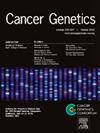The KRAS p.Ala146Thr mutation promotes the proliferation of colorectal cancer cells via CDK1-mediated ERK signaling
IF 2.1
4区 医学
Q4 GENETICS & HEREDITY
引用次数: 0
Abstract
KRAS is the most frequently mutant human oncogene, with mutations present in more than 30% of colorectal cancer (CRC) cases. A rare somatic mutation in KRAS, NM_004985.5 : c.436G>A (p.Ala146Thr), was identified in carcinoma tissues from two CRC patients using Sanger sequencing. An alternative transcript of CDC37 was identified that retained intron 3. No splicing variant was detected within the coding exons and exon-intron boundaries of CDC37. The transcript encoded both truncated and full-length CDC37 proteins. Furthermore, KRAS, CDC37 and HSP90 interacted with each other. The expression levels of HSP90 and CDC37 in carcinoma tissues with the KRAS p.Ala146Thr mutation were higher than those in para-carcinoma tissues. Notably, the p.Ala146Thr mutation significantly upregulated the expression of CDK1, which in turn promoted CRC cell proliferation through activation of ERK signaling. These findings uncover a novel molecular mechanism underlying CRC pathogenesis associated with the KRAS p.Ala146Thr mutation and provide potential insights for developing targeted therapies for this subset of CRC.
KRAS p.a ala146thr突变通过cdk1介导的ERK信号传导促进结直肠癌细胞的增殖
KRAS是最常见的突变人类癌基因,在超过30%的结直肠癌(CRC)病例中存在突变。通过Sanger测序,在两例结直肠癌患者的癌组织中发现了罕见的KRAS体细胞突变NM_004985.5: c.436G>A (p.Ala146Thr)。CDC37的另一个转录本被发现保留了内含子3。在CDC37的编码外显子和外显子-内含子边界内未检测到剪接变异。转录本编码截断和全长CDC37蛋白。此外,KRAS、CDC37和HSP90之间存在相互作用。KRAS p.a ala146thr突变的癌组织中HSP90和CDC37的表达水平高于癌旁组织。值得注意的是,p.a ala146thr突变显著上调CDK1的表达,进而通过激活ERK信号通路促进CRC细胞增殖。这些发现揭示了与KRAS p.a ala146thr突变相关的结直肠癌发病机制的新分子机制,并为开发针对该结直肠癌亚群的靶向治疗提供了潜在的见解。
本文章由计算机程序翻译,如有差异,请以英文原文为准。
求助全文
约1分钟内获得全文
求助全文
来源期刊

Cancer Genetics
ONCOLOGY-GENETICS & HEREDITY
CiteScore
3.20
自引率
5.30%
发文量
167
审稿时长
27 days
期刊介绍:
The aim of Cancer Genetics is to publish high quality scientific papers on the cellular, genetic and molecular aspects of cancer, including cancer predisposition and clinical diagnostic applications. Specific areas of interest include descriptions of new chromosomal, molecular or epigenetic alterations in benign and malignant diseases; novel laboratory approaches for identification and characterization of chromosomal rearrangements or genomic alterations in cancer cells; correlation of genetic changes with pathology and clinical presentation; and the molecular genetics of cancer predisposition. To reach a basic science and clinical multidisciplinary audience, we welcome original full-length articles, reviews, meeting summaries, brief reports, and letters to the editor.
 求助内容:
求助内容: 应助结果提醒方式:
应助结果提醒方式:


